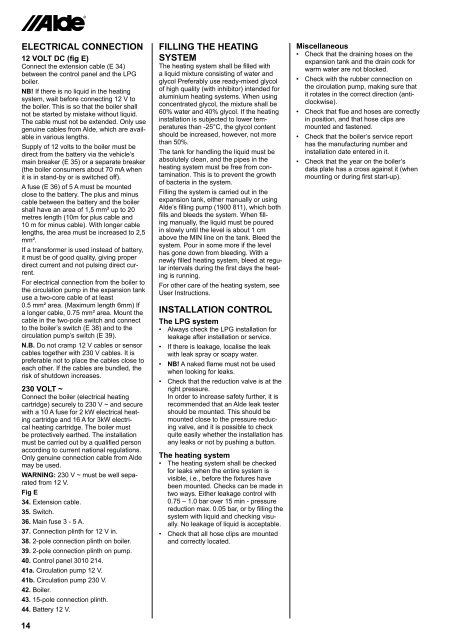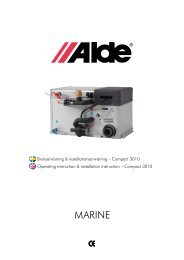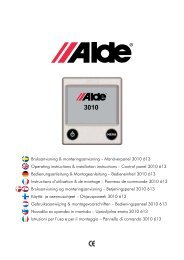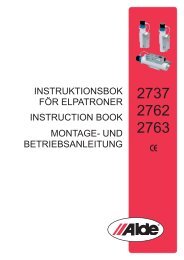Bruksanvisning & installationsanvisning – Compact 3010 Operating ...
Bruksanvisning & installationsanvisning – Compact 3010 Operating ...
Bruksanvisning & installationsanvisning – Compact 3010 Operating ...
You also want an ePaper? Increase the reach of your titles
YUMPU automatically turns print PDFs into web optimized ePapers that Google loves.
eLeCtriCaL ConneCtion<br />
12 VOLT DC (fig E)<br />
Connect the extension cable (E 34)<br />
between the control panel and the LPG<br />
boiler.<br />
nb! If there is no liquid in the heating<br />
system, wait before connecting 12 V to<br />
the boiler. This is so that the boiler shall<br />
not be started by mistake without liquid.<br />
The cable must not be extended. Only use<br />
genuine cables from Alde, which are available<br />
in various lengths.<br />
Supply of 12 volts to the boiler must be<br />
direct from the battery via the vehicle’s<br />
main breaker (E 35) or a separate breaker<br />
(the boiler consumers about 70 mA when<br />
it is in stand-by or is switched off).<br />
A fuse (E 36) of 5 A must be mounted<br />
close to the battery. The plus and minus<br />
cable between the battery and the boiler<br />
shall have an area of 1,5 mm² up to 20<br />
metres length (10m for plus cable and<br />
10 m for minus cable). With longer cable<br />
lengths, the area must be increased to 2,5<br />
mm².<br />
If a transformer is used instead of battery,<br />
it must be of good quality, giving proper<br />
direct current and not pulsing direct current.<br />
For electrical connection from the boiler to<br />
the circulation pump in the expansion tank<br />
use a two-core cable of at least<br />
0.5 mm² area. (Maximum length 6mm) If<br />
a longer cable, 0.75 mm² area. Mount the<br />
cable in the two-pole switch and connect<br />
to the boiler’s switch (E 38) and to the<br />
circulation pump’s switch (E 39).<br />
n.b. Do not cramp 12 V cables or sensor<br />
cables together with 230 V cables. It is<br />
preferable not to place the cables close to<br />
each other. If the cables are bundled, the<br />
risk of shutdown increases.<br />
230 VoLt ~<br />
Connect the boiler (electrical heating<br />
cartridge) securely to 230 V ~ and secure<br />
with a 10 A fuse for 2 kW electrical heating<br />
cartridge and 16 A for 3kW electrical<br />
heating cartridge. The boiler must<br />
be protectively earthed. The installation<br />
must be carried out by a qualified person<br />
according to current national regulations.<br />
Only genuine connection cable from Alde<br />
may be used.<br />
Warning: 230 V ~ must be well separated<br />
from 12 V.<br />
Fig e<br />
34. Extension cable.<br />
35. Switch.<br />
36. Main fuse 3 - 5 A.<br />
37. Connection plinth for 12 V in.<br />
38. 2-pole connection plinth on boiler.<br />
39. 2-pole connection plinth on pump.<br />
40. Control panel <strong>3010</strong> 214.<br />
41a. Circulation pump 12 V.<br />
41b. Circulation pump 230 V.<br />
42. Boiler.<br />
43. 15-pole connection plinth.<br />
44. Battery 12 V.<br />
14<br />
FiLLing tHe Heating<br />
system<br />
The heating system shall be filled with<br />
a liquid mixture consisting of water and<br />
glycol Preferably use ready-mixed glycol<br />
of high quality (with inhibitor) intended for<br />
aluminium heating systems. When using<br />
concentrated glycol, the mixture shall be<br />
60% water and 40% glycol. If the heating<br />
installation is subjected to lower temperatures<br />
than -25°C, the glycol content<br />
should be increased, however, not more<br />
than 50%.<br />
The tank for handling the liquid must be<br />
absolutely clean, and the pipes in the<br />
heating system must be free from contamination.<br />
This is to prevent the growth<br />
of bacteria in the system.<br />
Filling the system is carried out in the<br />
expansion tank, either manually or using<br />
Alde’s filling pump (1900 811), which both<br />
fills and bleeds the system. When filling<br />
manually, the liquid must be poured<br />
in slowly until the level is about 1 cm<br />
above the MIN line on the tank. Bleed the<br />
system. Pour in some more if the level<br />
has gone down from bleeding. With a<br />
newly filled heating system, bleed at regular<br />
intervals during the first days the heating<br />
is running.<br />
For other care of the heating system, see<br />
User Instructions.<br />
instaLLation ControL<br />
the LPg system<br />
• Always check the LPG installation for<br />
leakage after installation or service.<br />
• If there is leakage, localise the leak<br />
with leak spray or soapy water.<br />
• nb! A naked flame must not be used<br />
when looking for leaks.<br />
• Check that the reduction valve is at the<br />
right pressure.<br />
In order to increase safety further, it is<br />
recommended that an Alde leak tester<br />
should be mounted. This should be<br />
mounted close to the pressure reducing<br />
valve, and it is possible to check<br />
quite easily whether the installation has<br />
any leaks or not by pushing a button.<br />
the heating system<br />
• The heating system shall be checked<br />
for leaks when the entire system is<br />
visible, i.e., before the fixtures have<br />
been mounted. Checks can be made in<br />
two ways. Either leakage control with<br />
0.75 <strong>–</strong> 1.0 bar over 15 min - pressure<br />
reduction max. 0.05 bar, or by filling the<br />
system with liquid and checking visually.<br />
No leakage of liquid is acceptable.<br />
• Check that all hose clips are mounted<br />
and correctly located.<br />
miscellaneous<br />
• Check that the draining hoses on the<br />
expansion tank and the drain cock for<br />
warm water are not blocked.<br />
• Check with the rubber connection on<br />
the circulation pump, making sure that<br />
it rotates in the correct direction (anticlockwise).<br />
• Check that flue and hoses are correctly<br />
in position, and that hose clips are<br />
mounted and fastened.<br />
• Check that the boiler’s service report<br />
has the manufacturing number and<br />
installation date entered in it.<br />
• Check that the year on the boiler’s<br />
data plate has a cross against it (when<br />
mounting or during first start-up).







